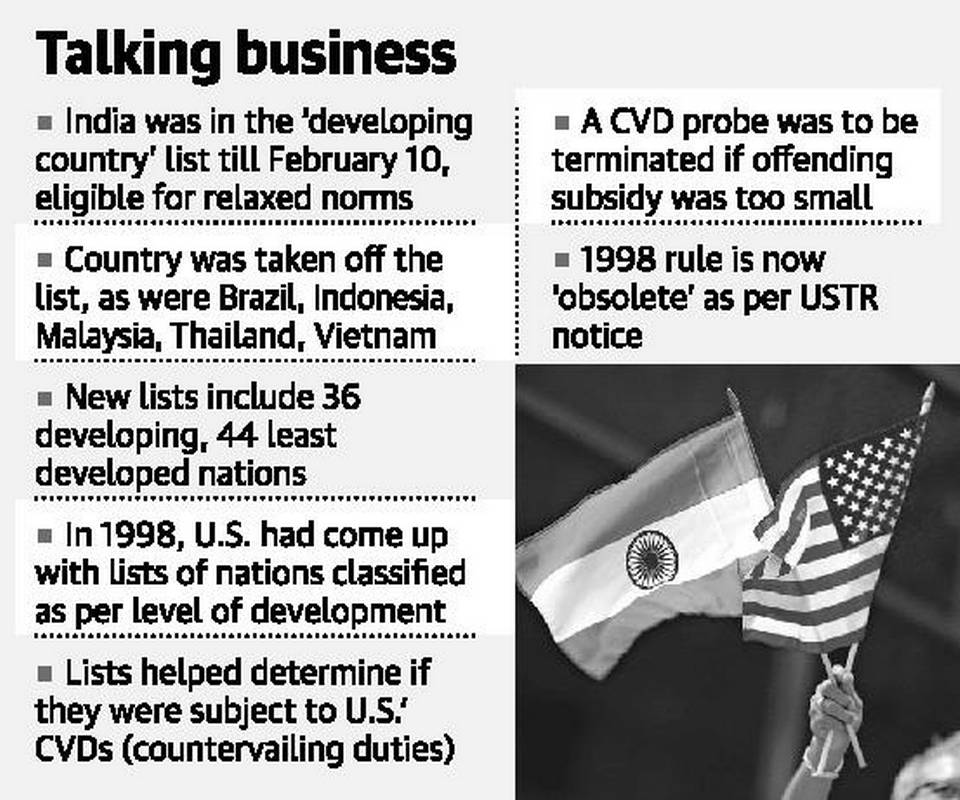International Relations
USTR takes India off Developing Country List
- 14 Feb 2020
- 5 min read
Why in News
The office of the United States Trade Representative (USTR) has taken off India from the list of developing and least-developed countries that are eligible to claim benefits for preferential treatment with respect to Countervailing duties (CVDs) investigations.
- The preferential treatment with respect to CVDs investigations falls under the US’ Generalized System of Preferences (GSP) scheme.
- Generalized System of Preferences (GSP) is an umbrella that comprises the bulk of preferential schemes granted by industrialized nations to developing countries.
- Countervailing duty (CVD) is an import tax imposed on certain goods in order to prevent dumping or counter export subsidies.
- Along with India, USTR has also eliminated other countries including Brazil, Indonesia, Hong Kong, South Africa, Malaysia, Thailand, Vietnam and Argentina from getting preferential treatment.
- The new lists consist of 36 developing countries and 44 least developed countries.
- The move comes ahead of US President Donald Trump’s visit to India to talk and potentially sign a trade deal.
Background
- The USA had come up with lists of countries classified as per their level of development to harmonise the USA preferential treatment laws with the World Trade Organization’s (WTO) Subsidies and Countervailing Measures (SCM) Agreement in 1998.
- The WTO Agreement on Subsidies and Countervailing Measures disciplines the use of subsidies, and it regulates the actions countries can take to counter the effects of subsidies.
- Under the agreement, a country can use the WTO’s dispute-settlement procedure to seek the withdrawal of the subsidy or the removal of its adverse effects. Or the country can launch its own investigation and ultimately charge extra duty (“countervailing duty”) on subsidized imports that are found to be hurting domestic producers.
- The classification of the countries (developed, developing and least-developed) is done according to the following criteria:
- Per capita Gross National Income or GNI.
- Share of world trade.
- Other factors such as Organisation for Economic Co-operation and Development (OECD) membership or application for membership, EU membership, and Group of Twenty (G20) membership, etc.
- Thus the country with per capita GNI above $12,375 or Rs 8.82 lakh, the share of more than 0.5% to the world trade and membership to the above-mentioned organisations is considered as a developed country by USTR.
India- As a USTR’s Developed Country
- According to USTR, India’s share in global trade was 2.1 % for exports and 2.6% for imports in 2017.
- Also India, along with nations like Argentina, Brazil, Indonesia, and South Africa, is part of the G20 bloc and G20 membership indicates that a country is developed.
- As the G20 members account for large shares of global economic output and trade.
- Further, being a part of G20 India can be classified as a developed country despite having a per capita GNI below $12,375.
Impact on India
- India is the largest beneficiary nation under the GSP, with total benefits from tariff exemptions amounting to $260 million in 2018, according to the data from the USTR’s office.
- In 2018, India exported goods worth $6.3 billion (as per USTR figures) to the US under the GSP, accounting for around 12.1% of India’s total export to that country.
- India no longer in the list of developing countries allows the USA to hold a CVD investigation.
- The CVD laws allow the US to hold an investigation into the trade policies of other countries to determine whether they are harming the US trade.
- If the investigation finds that India’s policies allow exporters to sell their products in the US at a lower rate the US can impose a countervailing duty, to make the Indian goods more expensive in the US markets.
- Despite having a minimal impact on India's overall outbound trade with the US, specific exports from India in a diverse set of sectors such as jewellery, leather, pharmaceuticals, chemicals and agricultural products may face higher costs and competition.




